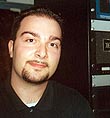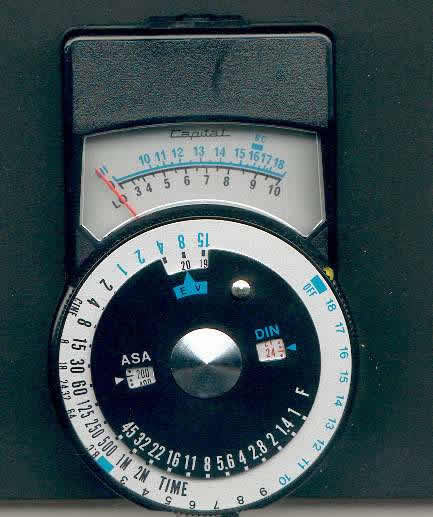|
|
 
|
|
Author
|
Topic: Screen brightness
|
Antonio Marcheselli
Phenomenal Film Handler

Posts: 1260
From: Florence, Italy
Registered: Mar 2000
|
 posted 04-13-2001 08:51 AM
posted 04-13-2001 08:51 AM





Hello everyone.Can this device be used to measure my screen luminance?  Thanks!! Bye
Antonio
| IP: Logged
|
|
|
|
|
|
|
|
Scott Norwood
Film God

Posts: 8146
From: Boston, MA. USA (1774.21 miles northeast of Dallas)
Registered: Jun 99
|
 posted 04-13-2001 08:39 PM
posted 04-13-2001 08:39 PM





I believe that there _is_ a conversion chart between footcandles and footlamberts, but your meter doesn't appear to measure footcandles, so that isn't really relevant unless you can dig up a footcandle meter.
I do have an old file that suggests this: set your meter for 100ASA, 1/50th second and take a reflected-light reading off the screen with the projector running without film. If you are getting 16fl on screen, the meter should read f/3.2. (This method was posted to the CML mailing list a while back.)
This "might" be useful to get a ballpark figure, but I suspect that you will want to beg, borrow, or steal (not really) the proper type of meter for this job, since the above method doesn't really take into account the evenness of illumination and many other factors. It would probably work better with a spot meter, and would probably not work at all with a digital meter (which would likely find the flicker to be disagreeable).
| IP: Logged
|
|
John Pytlak
Film God

Posts: 9987
From: Rochester, NY 14650-1922
Registered: Jan 2000
|
 posted 04-14-2001 06:15 AM
posted 04-14-2001 06:15 AM





To measure screen luminance, you need a meter that reads light REFLECTED from the screen. An incident light meter (that measures light falling on the meter) will not measure the effect of screen gain. Incident light is measured in FOOTCANDLES (or candelas). Reflected light is measured in FOOTLAMBERTS (or candelas per square metre).Standard SMPTE 196M specifies a screen luminance aim of 16 footlamberts, with an allowed range for theatres of 12 to 22 footlamberts. Here is an article I wrote about measuring screen luminance:
http://www.kodak.com/US/en/motion/newsletters/notes/june2000/pytlak.shtml ------------------
John P. Pytlak, Senior Technical Specialist
Worldwide Technical Services, Entertainment Imaging
Eastman Kodak Company
Research Labs, Building 69, Room 7419
Rochester, New York, 14650-1922 USA
Tel: 716-477-5325 Cell: 716-781-4036 Fax: 716-722-7243
E-Mail: john.pytlak@kodak.com
Web site: http://www.kodak.com/go/motion
| IP: Logged
|
|
|
|
Steve Guttag
We forgot the crackers Gromit!!!

Posts: 12814
From: Annapolis, MD
Registered: Dec 1999
|
 posted 04-15-2001 12:17 AM
posted 04-15-2001 12:17 AM




Not necessarily Josh...how the shutter is desinged...I recently did a theatre where the norm was 22fL and it looked better than most theatres with 16fL...I attribute this to the single bladed shutter spinning faster. There are other ways, like increasing the shutter frequency (like 3-blades). Steve ------------------
"Old projectionists never die, they just changeover!"
| IP: Logged
|
|
John Pytlak
Film God

Posts: 9987
From: Rochester, NY 14650-1922
Registered: Jan 2000
|
 posted 04-15-2001 06:54 AM
posted 04-15-2001 06:54 AM





Perception of shutter flicker is subjective, and sensitivity to it depends upon the person. Flicker is more noticeable with peripheral vision, and less noticeable when you are looking directly at something. Generally, shutter flicker is more noticeable at high levels of screen luminance. The SMPTE standard allows up to 22 footlamberts for theatres. Steve is correct that going to a 3-blade shutter almost completely eliminates flicker perception at any light level. Higher frame rates can also be used. Todd-AO ("Oklahoma!", "Around the World in 80 Days") wisely used 30 frames per second to minimize flicker and strobing on very wide screens (peripheral vision), but the extra cost and need for compatibility with general release prompted a return to 24fps. Many theme park presentations and "ride films" still use higher frame rates (30fps, 48fps, 60fps) to minimize flicker and strobing and achieve greater realism on the screen at very high screen luminance. It is very important that the power supply to the xenon lamp be very well filtered. Even a small amount of AC current ripple can reduce lamp life, and leads to visible flicker as the power line frequency "beats" against the shutter frequency. ------------------
John P. Pytlak, Senior Technical Specialist
Worldwide Technical Services, Entertainment Imaging
Eastman Kodak Company
Research Labs, Building 69, Room 7419
Rochester, New York, 14650-1922 USA
Tel: 716-477-5325 Cell: 716-781-4036 Fax: 716-722-7243
E-Mail: john.pytlak@kodak.com
Web site: http://www.kodak.com/go/motion
| IP: Logged
|
|
|
|
|
|
All times are Central (GMT -6:00)
|
|
Powered by Infopop Corporation
UBB.classicTM
6.3.1.2
The Film-Tech Forums are designed for various members related to the cinema industry to express their opinions, viewpoints and testimonials on various products, services and events based upon speculation, personal knowledge and factual information through use, therefore all views represented here allow no liability upon the publishers of this web site and the owners of said views assume no liability for any ill will resulting from these postings. The posts made here are for educational as well as entertainment purposes and as such anyone viewing this portion of the website must accept these views as statements of the author of that opinion
and agrees to release the authors from any and all liability.
|

 Home
Home
 Products
Products
 Store
Store
 Forum
Forum
 Warehouse
Warehouse
 Contact Us
Contact Us




 Printer-friendly view of this topic
Printer-friendly view of this topic
















